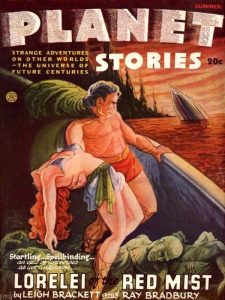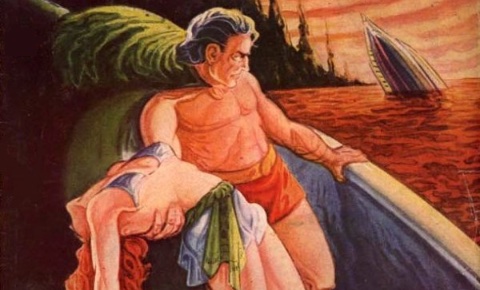 In his introduction to Irwin Porges’s EDGAR RICE BURROUGHS: THE MAN WHO CREATED TARZAN, Ray Bradbury suggested that during the summer of 1930, “a mob of boys and girls” were running away from him. That he made the summer excruciating and unbearable “for everyone.” Why you may ask?
In his introduction to Irwin Porges’s EDGAR RICE BURROUGHS: THE MAN WHO CREATED TARZAN, Ray Bradbury suggested that during the summer of 1930, “a mob of boys and girls” were running away from him. That he made the summer excruciating and unbearable “for everyone.” Why you may ask?
You see my problem was Edgar Rice Burroughs and Tarzan and John Carter, Warlord of Mars.
Problem, you ask. That doesn’t sound like much of a problem.
Oh, but it was. You see, I couldn’t stop reading those books. I couldn’t stop memorizing them line by line and page by page. Worst of all, when I saw my friends, I couldn’t stop my mouth. The words just babbled out. Tarzan this and Jane that, John Carter here and Dejah Thoris there. And when it wasn’t those incredible people it was Tanar of Pellucidar or I was making noises like a tyrannosaurus rex and behaving like a Martian thoat, which, everyone knows, has eight legs.
In the view of Ray Bradbury, Edgar Rice Burroughs stands above other writers because of his . . .
. . . unreason, because of his natural impulses, because of the color of the blood running in Tarzan’s veins, because of the blood on the teeth of the gorilla, the lion, and the black panther. Because of the sheer romantic impossibility of Burroughs’ Mars and its fairytale people with green skins and the absolutely unscientific way John Carter traveled there. Being utterly impossible, he was the perfect fast-moving chum for any ten-year-old boy. For how can one resist walking out of a summer night to stand in the middle of one’s lawn to look up at the red fire of Mars quivering in the sky and whisper, “Take me home.”
As a writer, Ray Bradbury first visited Mars in print in the story, “The Piper,” self-published in the Spring 1940 issue of his fanzine, FUTURIA FANTASIA. A revised version under the same title would appear in the February 1943 number of THRILLING WONDER STORIES.
Originally published as by Ron Reynolds, “The Piper” is far removed from the Mars depicted in his seminal work, THE MARTIAN CHRONICLES. The first of his “Chronicles” stories — “The Million Year Picnic” — would first appear in the Summer 1946 PLANET STORIES. “Lorelei of the Red Mist,” a novella started by his friend and mentor, Leigh Brackett, and completed by Bradbury would also run in the same issue.
Initially released by Doubleday & Company seventy years ago today, THE MARTIAN CHRONICLES was a “fix-up” novel comprised of a mixture of previously published stories and bridge chapters. Crediting Sherwood Anderson’s WINESBURG, OHIO and John Steinbeck’s THE GRAPES OF WRATH as major influences on the book’s structure, Ray Bradbury labeled his book, a “half-cousin to a novel.”
Inspired by a suggestion by Doubleday editor Walter I. Bradbury (no relation), the initial outline for THE MARTIAN CHRONICLES was put together on a portable typewriter at the Sloane House YMCA in New York City in 1949. As the author later recalled, “It was a typical hot June night in New York. Air conditioning was still a luxury of some future year. I typed until 3 A.M., perspiring in my underwear as I weighted and balanced my Martians in their strange cities in the last hours before arrivals and departures of my astronauts.”
According to Sam Weller’s biography of the author — THE BRADBURY CHRONICLES: THE LIFE OF RAY BRADBURY — Walter Bradbury loved the idea behind THE MARTIAN CHRONICLES:
This idea for a novel-in-stories would provide a mirror for humanity, its faults, foibles, and failures. The book would be a cautionary tale, warning against the cultural perils that lay ahead.
Recognizing Ray Bradbury as a “rising literary talent who could be a key player in Doubleday’s new science fiction line,” the editor offered the writer a book deal on the spot, sending him back to Southern California with a check for $1500 for a pair of books.
Over the next year, Ray Bradbury reviewed all of his Martian stories, selecting and revising those to be included in his “book of stories pretending to be a novel.” Initially compiled as eighteen stories and eleven bridge chapters, it was paired down by the author and his editor, Walter Bradbury. Four segments were removed from the final manuscript.
THE MARTIAN CHRONICLES would be welcomed by both the science fiction community and, later, by mainstream critics led by the respected author, Christopher Isherwood. It has remained in print since 1950 and has been adapted for radio, comic books, theater, television, and as an opera and a video game. To date, although both MGM and Paramount have owned the book’s film rights, no motion picture version has ever been produced.
In Sam Weller’s book, LISTEN TO THE ECHOES: THE RAY BRADBURY INTERVIEWS, the Science Fiction Grand Master and “Poet of the Pulps” suggests:
I love to say it because it upsets everyone terribly — Burroughs is probably the most influential writer in the entire history of the world . . . . By giving romance and adventure to a whole generation of boys, Burroughs caused them to go out and decide to become special. That’s what we have to do for everyone, give the gift of life with our books. Say to a girl or boy at age ten: “Hey, life is fun! Grow tall!” I’ve talked to more biochemists and more astronomers and technologists in various fields, who, when they were ten years old, fell in love with John Carter and Tarzan and decided to become something romantic. Burroughs put us on the moon. All the technologists read Burroughs.
Like Edgar Rice Burroughs before him, Ray Bradbury has inspired a fair share of “technologists.” As astronaut Chris Hadfield wrote in his introduction to the 2015 Folio Society edition of THE MARTIAN CHRONICLES:
The spaceship was improbable, at best. Having been blasted from the Earth’s surface, pushed hard to an incredible speed, and then having to endure a silent nine-month coast through interplanetary space, it was now being pulled unstoppably by the gravity of planet Mars, inexorably down into the Martian atmosphere. Jealously protecting its precious cargo, a carton-of-eggs rover named Curiosity, the ship gradually, deliberately gave its life to the wicked heat, the punishing deceleration and the sudden, final impact onto the dusty surface of Mars. And as the newly landed Curiosity slowly, safely awoke and began to look around, its robot eyes showed us a new place in our history – just south of Mars’ equator, on an ancient sea floor in Gale Crater, forevermore known as Bradbury Landing. The dreamers and scientists and engineers who guided Curiosity to the landing site chose that name because “many of us and millions of other readers were inspired in our lives by stories Ray Bradbury wrote to dream of the possibility of life on Mars.” Those stories, the sparks of imagination that helped fire the flames that lifted Curiosity, are . . . THE MARTIAN CHRONICLES.
(At PulpFest 2020, we’ll be celebrating the 100th anniversary of the birth of author Ray Bradbury. Our keynote address will be presented by Professor Garyn G. Roberts. Bradbury’s pal for more than thirty years, Garyn will discuss the life and works of the Science Fiction Grand Master and “Poet of the Pulps,” including “The Million Year Picnic,” originally published in the Summer 1946 PLANET STORIES and featuring front cover art by Chester Martin.
We’ll also have presentations on Bradbury in comic books, television, and film. Filling out our Bradbury salute will be several presentations concerning Mars in fiction, a look at early science fiction fandom, and more.)






